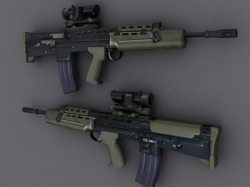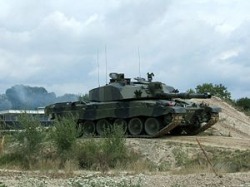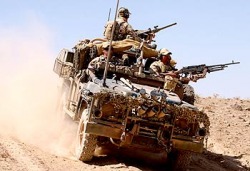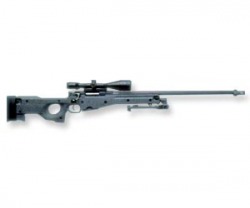Weapons
This part of my site is dedacated to the standard weapons used by the army. I try to get as much facts as possible, But if you see somethimg that is not true or that is only half true,please feel free to email me.NB. This is not the official army site.I am only a fan of the army.
All Facts Provided by Wikipedia.
L85A2 (SA80)

From Wikipedia, the free encyclopedia
The SA80 (Small Arms for the 1980s) is a family of 5.56 mm small arms designed and produced (until 1988) by the Royal Small Arms Factory at Enfield Lock. In 1988 production of the rifle was transferred to the Royal Ordnance’s Nottingham Small Arms Facility (later British Aerospace, Royal Ordnance; now BAE Systems Land Systems Munitions & Ordnance).
Development
The rifle’s history dates back to the late 1940s, when an ambitious programme to develop a new cartridge and new class of rifle was launched in the United Kingdom based on combat experience drawn from World War II. Two 7 mm prototypes were built in a “bullpup” configuration, designated the EM-1 and EM-2. When NATO adopted the 7.62x51mm rifle cartridge as the standard caliber for its service rifles, further development of these rifles was discontinued (the British Army chose to adopt the 7.62 mm L1A1 SLR automatic rifle, which is a license-built version of the BelgianFN FAL).
In 1969 the Enfield factory began work on a brand new family of weapons, chambered in a newly designed British 4.85x49mm intermediate cartridge. The system was to be composed of two weapons: an individual weapon, the XL64E5 rifle and a light support weapon known as the XL65E4light machine gun. Both designs were based on the 5.56 mmAR-18 assault rifle, which was manufactured in Britain by Sterling Armament Company alongside thier similar but improved SAR-87.
In 1976 the prototypes were ready to be trialed, however after NATO’s decision to standardize ammunition among its members, Enfield engineers re-chambered the rifles to the American 5.56x45mm M193 cartridge. The newly redesigned 5.56 mm version of the XL64E5 became the XL70E3. The left-handed XL68 was also re-chambered in 5.56x45mm as the XL78. The 5.56mm Light Support Weapon variant, the XL73E3, developed from the XL65E4, was noted for the full length receiver extension with the bipod under the muzzle now indicative of the type.[1] In this configuration both weapons underwent a series of evaluations, with a small batch of pre-production weapons being used by British soldiers during the Falklands conflict.
Further development out of the initial so-called "Phase A"[1] pre-production prototypes led to the XL85 and XL86. While the XL85E1 and XL86E1 were ultimately adopted as the L85 and L86 respectively, a number of additional test models were produced. The XL85E2 and XL86E2 were designed to an alternate build standard with 12 components different from E1 variants, including parts of the gas system, bolt, and magazine catch. Three series of variants were created for "Environmental User Trials." XL85E3 and XL86E3 variants were developed with 24 modified parts, most notably a plastic safety plunger. The E4's had 21 modified parts, no modification to the pistol grip, and an aluminium safety plunger, unlike the E3 variants. Lastly, the E5 variants had 9 modified parts in addition to those from the E3/E4 variants.[1]
After receiving feedback from users, addressing concerns and incorporating the several design changes noted, including adopting the rifle for use with the heavier Belgian SS109 version of the 5.56x45mm cartridge and improving reliability, the rifle was accepted into service with the British Army in 1985, designated the SA80 (Small Arms for the 1980s). The SA80 family consists of the L85A1 IW (Individual Weapon) and the L86A1 LSW (Light Support Weapon).
In 1994 production was officially completed. Over 350,000 L85A1 rifles and L86A1 light machine guns had been manufactured for the United Kingdom. They are also in use with the armed forces of Jamaica.
Design details
The L85A1 is a selective-fire gas-operatedassault rifle that uses ignited powder gases bled through a gas port above the barrel to provide the weapon’s automation. The rifle uses a short stroke gas piston system (the piston travels inside a gas tube located above the barrel) and a three-position adjustable gas regulator; the first gas setting is used for normal operation, the second – for use in difficult environmental conditions and the third setting is used to propel rifle grenades. The weapon uses a rotating cylindrical bolt that contains 7 radially-mounted locking lugs, an extractor and casing ejector. The bolt’s rotation is controlled via a cam pin that slides inside a camming guide machined into the bolt carrier. The weapon fires from a closed bolt.
The rifle is fed from a STANAG magazine, usually with the 30-round capacity. The magazine release button is placed above the magazine housing, at the left side of the receiver.
The L85A1 is equipped with a hammer striking mechanism and a trigger mechanism with a fire-control selector that enables semi-automatic fire and fully automatic fire (the fire selector lever is located at the left side of the receiver, just aft of the magazine). A cross-bolt type safety that prevents accidental firing is located above the trigger; the “safe” setting disables the trigger. When the last cartridge is fired from the magazine the bolt and bolt carrier assembly lock to the rear.
The rifle features a barrel with a slotted flash suppressor, which also serves as the base for attaching and launching rifle grenades and mounting a bayonet.
The rifle is built in a “bullpup” configuration, with a forward mounted pistol grip. The main advantage of this configuration is the overall length of the rifle can be reduced without compromising the barrel length, hence the overall length is shorter than the M4 Carbine, but the barrel length is longer than the M16. However, the adoption of this layout without a conversion kit such as that availible for the FAMAS or Steyr AUG, also means the rifle must be used exclusively right-handed since the ejection port and cocking handle (which reciprocates during firing) are on the right side of the receiver, making left-handed firing impossible.
L85A1 rifles used by the Royal Marines, Infantry Soldiers (and other soldiers with a dismounted Close Combat role) and the RAF Regiment are equipped with a SUSAT (Sight Unit Small Arms, Trilux) optical sight, with a fixed 4x magnification and an illuminated aiming pointer powered by a variable tritium light source (as of 2006 almost all British Army personnel deploying on operations have been issued SUSATs). Mounted on the SUSAT’s one-piece, pressure die-cast aluminium body is a mechanical back-up iron sight that consists of a front post and small rear aperture. Rifles used with other branches of the armed forces when not on operations are configured with fixed iron sights, consisting of a flip rear aperture (housed inside a carry handle, mounted to the top of the receiver, replacing the SUSAT sight) and a forward post, installed on a bracket above the gas block. The rear sight can be adjusted for windage, and the foresight – elevation. In place of the SUSAT a passive night vision CWS scope can be used, and also – independent of the SUSAT – a laser pointer can be mounted.
The L85A1 comes equipped with: a sling, blank firing adapter, cleaning kit and a blade-type bayonet, which coupled with the sheath can double as a wire cutter (the sheath contains a small saw). The rifle can be adapted to use .22 LR ammunition with a special conversion kit. The rifle can also accommodate a 40 mm under-barrel grenade launcher.
The weapon’s receiver is made from stamped steel, reinforced with welded and riveted machined steel inserts. Synthetics were also used (i.e. the handguards, pistol grip, butt pad and cheek rest were all fabricated from nylon).
Challenger 2 tank

The FV4034 Challenger 2 is the main battle tank (MBT) currently in service with the armies of the United Kingdom and Oman. Built by the British company Vickers Defence Systems (now part of BAE Systems Land and Armaments). The manufacturer advertises it as the world's most reliable main battle tank[2] although military operations in desert conditions have exposed significant problems which had to be addressed.[3] As of January 2008, two Challenger 2s have been damaged and one destroyed (by a friendly fire engagement with another Challenger II) in combat.
Challenger 2 is an extensive redesign from Challenger 1, the MBT from which it was developed. It uses the basic hull and automotive parts of its predecessor but all else is new. Fewer than 5% of components are interchangeable.
Challenger 2 has now replaced Challenger 1 in service with the British Army and is also used by the Royal Army of Oman. The UK placed orders for 127 Challenger 2 tanks in 1991 and an additional 259 in 1994. Oman ordered 18 of the tanks in 1993 and a further 20 in November 1997. Challenger 2 entered service with the British Army in 1998, with the last delivered in 2002. It is expected to remain in service until 2035. Deliveries for Oman were completed in 2001. Challenger 2 has seen operational service in Bosnia, Kosovo and Iraq (2003–present).
Land Rover Wolf

The Land Rover Wolf is a military utility vehicle in service with UK Armed Forces and the Dutch Marine Corps. The vehicle is famous for being the primary utility vehicle of the British Army.
The term "Wolf" was a project name used by Land Rover to cover the British Army's recent range of vehicles. The name is not officially used by the MoD but adopted by soldiers as a generic term (standing for Wheel On Left Face,to describe the new position of the spare wheel). The project designations were MoD: Higher Specification (HS) or Land Rover Ltd: eXtra Duty (XD) and there are twenty-three variants.[1] The term "Wolf" should not be confused with the militarised Mercedes Geländewagen based "Wolf" marketed by Rheinmetall Defence.
Truck Utility Light/Medium
The Wolf is a UK MoD bespoke militarised version of the Land Rover Defender. Designated in service as Truck Utility Light or Truck Utility Medium (TUL / TUM (HS)) the TUL was based on the shorter wheel base Defender 90, whilst the TUM was based on the Defender 110, the Wolf carries a variety of crews, equipment and communication and information systems for commanders.
Some Wolf Land Rovers are winterised and waterproofed: a snorkel allows the vehicle to wade through water up to windscreen level and an engine fluids heater is fitted to pre-warm the engine – along with the other modifications to enable the vehicle and crew to operate in extreme conditions. Other modifications are made for operations in tropical environments. The Royal Marines operate a a special deep-wading version for amphibious assaults. Fitted with a 'periscope' snorkel, waterproofed electrical systems and instruments, and prepared with grease and graphite lubricant on practically every moving part, these versions can run with the entire vehicle submerged if needed. The tailgate is held open by struts to allow water into the vehicle to prevent it floating away, and to allow water to rapidly drain after reaching the shore. In training exercises the vehicles are operated in depths so that just the driver's head and shoulders are clear of the water.
[edit] Weapons Mount Installation Kit A variant of TUM is the Weapons Mount Installation Kit (WMIK, pronounced ‘Wimik’[2]) for use as reconnaissance and close fire support vehicles. WMIKs are manufactured jointly by Land Rover and Ricardo Vehicle Engineering and feature a strengthened chassis and are stripped down, fitted with roll cages and weapons mounts. Typically the vehicle will carry one 12.7 mm Heavy Machine Gun, 7.62 mm General Purpose Machine Gun (GPMG) or on occasion the MILAN ATGM, on the rear ring-mount, with an additional pintle mounted GPMG on the front passenger side. In late 2006, the MoD announced it was purchasing 40 new belt fed Automatic Lightweight Grenade Launchers (ALGL) made by Heckler and Koch (HK GMG) that can fire up to 360 grenades per minute with a range of up to 1.5 km.; they are to be mounted on WMIKs in Afghanistan.
The vehicles have become a symbol of British forces in Iraq and Afghanistan. In keeping with their hearts and minds philosophy they were chosen for patrol duties instead of armoured fighting vehicles such as the Challenger 2 MBT and the Warrior IFV. Following a spate of incidents, there has been concern that the unarmoured nature of the Wolf exposes the crews to excessive danger, and they are being supplemented by more heavily armoured vehicles such as the Vector and Mastiff Protected Patrol Vehicles.
The Land Rover is also being supplemented by the now British built Pinzgauer and Alvis Panther in some utility and liaison roles and the new Supercat MWMIK due to a shortfall of WMIKs. There are reports [3] that some of this equipment may have to be sold at below cost once operations in Iraq are completed as the Treasury has refused to cover the cost of replacement. In Afghanistan "an average of one of these vehicles a week" is being lost, and with replacements often arriving late; a "fifth of the fleet" of WMIKs is currently "damaged or has been destroyed by enemy fire" [4].
L96A1 Sniper Rifle

The Accuracy International Arctic Warfare rifle is a family of bolt-action sniper rifles designed and manufactured by the British company Accuracy International. It has proved popular as a civilian, police and military rifle since its introduction in the 1980s.
Generally Arctic Warfare rifles are outfitted with a Schmidt & Bender PM II [1] telescopic sight with fixed power of magnification or with variable magnification. Variable telescopic sights can be used if the operator wants more flexibility to shoot at varying ranges, or when a wide field of view is required. Accuracy International actively promotes fitting the German made Schmidt & Bender PM II product line as sighting components on their rifles, which is rare for a rifle manufacturer. However, the German and Russian Armies preferred a telescopic sight made by Zeiss [2] over Accuracy International's preference.
History
The Accuracy International PM (Precision Marksman) rifle was entered into a British competition in the early 1980s as a replacement for the Lee-Enfield derived sniper rifles then in use by the British Army (e.g. L42A1). Accuracy International's name for this rifle was the PM; the Army designated it as the L96A1 and outfitted it with Schmidt & Bender 6x42 telescopic sights. It was selected over the Parker-Hale M85.
A few years later, the Swedish military were also on the hunt for a new rifle, and Accuracy International entered an upgraded version of the PM, now known as the AW or Arctic Warfare. This was the start of the Arctic Warfare name, which would become the primary name of the rifle family despite its earlier names.
The rifle now featured special de-icing features allowing it to be used effectively at temperatures as low as -40 °C. The stockhole, bolt, magazine release and trigger guard on the AW are large enough to facilitate use with heavy Arctic mittens. This version was accepted into use by the Swedish Army in 1988 as the Psg 90.
The modifications to the original PM or L96A1 made the British Army decide to order the 'improved' AWP version too and designated it as the L118A1. The rifles where outfitted with Schmidt & Bender 3-12x50 PM II telescopic sights. This rifle has seen service in recent conflicts such as Operation Granby and Operation Telic.
It has since spawned an entire family of sniper rifles using the Arctic Warfare name, and has been adopted by a number of other countries, including Australia, Belgium, Germany, Indonesia, Ireland, Latvia, Malaysia, Norway, The Netherlands, Russia, Singapore, Spain, Sweden and the United Kingdom. Other AI rifles descended from the L96A1 include the AI AE, and the AI AS50 (see variants below).
Most Arctic Warfare rifles are chambered for the 7.62x51mm NATO cartridge, but it can also be fitted for other cartridges. It is mounted with a muzzle brake to cut down on recoil, jump and flash.
Each country's rifles differ slightly. The Swedish Psg 90 for example, uses a different Schmidt & Bender scope to that of the L42A1, and can also use sabot rounds. The German Bundeswehr adopted a folding-stock Magnum version of the AW chambered in .300 Winchester Magnum (7.62x67mm) and with optics made by the German company Zeiss as the Scharfschützengewehr 22 (G22).
The AW's unique complete parts interchange ability and reliability in adverse weather conditions have made it a popular, if expensive, weapon. The rifle offers good accuracy (a capable marksman can expect ≤ 0.5 MOA consistent accuracy with appropriate ammunition), and its maximum effective range with a Schmidt & Bender 6 x 42 PM II scope is around 800 m.
The Arctic Warfare family's main commercial competitor/equivalent on the high end factory sniper rifle market is the Sako TRG product line, that is capability-wise, generally on par with the Arctic Warfare system but somewhat less expensive.
Design details
The AW system is almost unique in being a purpose-designed sniper rifle, rather than an accurised version of an existing, general-purpose rifle. Rather than a traditional wooden or polymer rifle stock, the AW is based on an aluminium chassis which extends the entire length of the stock. All other components, including the receiver, are bolted directly to this chassis. Two hollow polymer "half thumbhole stocks", usually green, are in turn bolted to the chassis, creating a remarkably rugged, yet for its sturdiness comparatively light, weapon. The modular design of the AW system allows for a high degree of flexibility, serviceability and reparability under field and combat conditions.
The AW is usually equipped with an integrated bipod and it also has a monopod mounted on the buttstock.
The AI receiver is bolted with 4 screws and permanently bonded with epoxy materiel to the aluminum chassis and was designed for ruggedness, simplicity and ease of operation. To this end, the heavy-walled, flat-bottomed, flat-sided receiver is a stressed part, machined in-house by AI from a solid piece of forged carbon steel. AW rifles are offered in two action lengths - standard AW (short) and long SM (magnum). The six bolt lugs, which are arranged in two rows of three lugs each, engage a heat-treated, steel locking ring insert pinned inside the front bridge of the action. The ring can be removed and replaced to refresh headspace control on older actions. The AW system cast steel bolt has a 0.75 inch (19.05 mm) Ø combined with gas relief holes in a 0.785 in (19.94 mm) Ø bolt body and front action bridge allowing high-pressure gases a channel of escape in the rare event of a cartridge case head failure. Against penetrating water or dirt the bolt has milled slots, which also prevent freezing or the occurrence of other disturbances. Contrary to conventional bolt-action rifles the bolt handle is bent to the rear, which eases the repeating procedure for the operator and reduces the contours of the weapon. The action cocks on opening with a short, 60 degree bolt throw and has a non-rotating (fixed) external extractor and an internal ejector. Firing pin travel is 0.26 in (6.6 mm) to keep lock times to a minimum. Finally, a 11 mm integral dovetail rail located above the receiver is designed to accommodate a number of different types of optical or electro-optical sights.
Cartridges are fed through the bottom of the receiver using a detachable, double-column, steel magazine.
A three-position, firing pin blocking safety lever on the bolt shroud allows the bolt to be manipulated with the safety on. If the weapon is decocked, the firing pin is tactile at the end of the bolt-action, making it possible to feel if the weapon is ready to fire or not in poor visibility. The safety of the weapon is also positioned at the rear. It carries two coloured markings: white point – safety on, red point – safety off.
The free-floating, heavy, stainless steel barrels (stainless steel barrels resist throat erosion better than normal barrels) for the available cartridge chamberings all have a different length, groove cutting and rifling twist rate optimized for their respective chambering and intended ammunition. If the consistent accuracy requirement of an operator is no longer met the barrel can fairly easy be renewed. This is normal practice for active high performance precision rifle operators, who regard barrels as expendable items.
